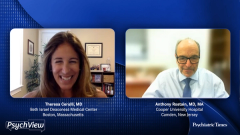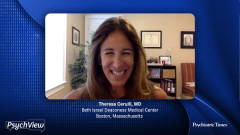
Treatment Goals and Shared Decision Making for Adults With ADHD
Experts in attention-deficit/hyperactivity disorder (ADHD) discuss the importance of patient education and shared decision-making in working toward treatment goals.
Episodes in this series

Theresa Cerulli, MD: I want to move to treatment to create some hope.
Anthony Rostain, MD, MA: Sure.
Theresa Cerulli, MD: But most importantly, to remember, because there is such the psychosocial piece, and it's not just, here's your medication, but what else can we do for support? So, I talk in terms of treatment, before we get into the nitty gritty with medications, I talk about a couple's coaching approach. It's in these situations where this is a systems issue if part of the system is weaker in one area, or the supports and elsewhere, and not play the blame game. So, a big part of what I do is really helping people understand how their brain works, helping them accept what they're good at, not good at. And same with the family system around them –
Anthony Rostain, MD, MA: So important.
Theresa Cerulli, MD: That it’s not pointing fingers. Exactly.
Anthony Rostain, MD, MA: For example, I won't start a treatment plan until we've done enough psychoeducation with both the individual and their key partner if they're in a partnered relationship, because otherwise, again, everybody has these unrealistic expectations of what a medication might do, when in fact there's a lot of learning about what your brain can do well, and also what your brain doesn't do so well. And beginning with environmental adjustments, making the schedules, doing all the things that people I always say pills don't teach skills. So, ultimately what may be there are skill deficits, that people just don't know how to manage. That's the worst part of all, especially for people that are bright when they move into the adult world, and they're supposed to self-manage and they don't have an easy time of it. There's a constant procrastination and avoidance that sets in and that gets other people angry. “Hey, you said you were going to do this, you put it off. Why, why, why?”
Theresa Cerulli, MD: And personalize that.
Anthony Rostain, MD, MA: Oh yes. They'll personalize it. “You don't care enough. I'm tired of being second; you're not paying attention in the right way.” No. I love what you do because I think that coaching and talking about how it's impacting, say, if someone's in a marriage or an intimate relationship, how is this affecting the relationship and what can you do to learn to understand and communicate better around those conflicts that emerge?
Theresa Cerulli, MD: The other thing I wanted to share with clinicians listening today is that the shared decision-making—and I'm not talking about just having the partner or spouse present when we're making decisions—shared decision-making in terms of choices between myself and the patient in terms of how to move forward with treatment and what's important to them. So, in shared decision-making, they're not picking the medication or the coaching approach, but at least if I give some choices, narrow down and say, “if it were me, here's how I might proceed.” Or “here's why I think this might be a good fit,” or “an alternative is,” and then at least have discussed a couple of pathways and where we can begin. I think that for me, that shared decision-making empowers somebody who's otherwise probably had low self-esteem, been told what they're not doing right, and might not have paid attention to some of the details if I give too much information. But at least that feeling of, “I'm not stuck.” And you're not just pushing uphill and having to make some choices. So, I call it shared decision-making. And it plays a big role in how I approach treatment selection. How about you?
Anthony Rostain, MD, MA: I think that's absolutely right. It also helps define not only the parameters and the goals and the methods for reaching those goals but the timeframe. There's got to be a realistic sense that this is a process and we're embarking on it together, and we're going to try different things according to your priorities. And in between our visits, there are going to be tasks you're going to want to take on, and we'll monitor closely how you're doing with those tasks because the purpose of treatment is to help people function better. It's not just to reduce symptoms, it's improving the functioning in various domains of life. And that's why it's important to have it be shared decision-making and a real conversation.
Theresa Cerulli, MD: A true clinician! To hear you say, “We're trying to help people function and we fill out when medications are tested, and the DSM [Diagnostic and Statistical Manual of Mental Disorders] criteria develop. We're talking about symptoms and the checklist, and you're checking the boxes, and then you get to real life. And people that care about how they're doing it at home.
Anthony Rostain, MD, MA: For some of them the problem is, “I want to be able to have a conversation with my kids without getting mad or with my partner,” and for others it's, “I want to be able to get through my workday more effectively or more efficient.” For others, it's, “Hey, I want to sit down and read a book and enjoy it.” There are different priorities for people, and it's to get them to state what they're really aiming for. And when they have a list of 20 things, you've got to say, “Well, hey, let's pick the first 1 or 2 out of that list and aim for those goals.”
Theresa Cerulli, MD: I'm such a fan of shared decision-making. I often found myself using the word “we.” “What are we going do?” And that “You're not alone in this. I'm right there with you. We're going to figure it out.”
Transcript edited for clarity
Newsletter
Receive trusted psychiatric news, expert analysis, and clinical insights — subscribe today to support your practice and your patients.














